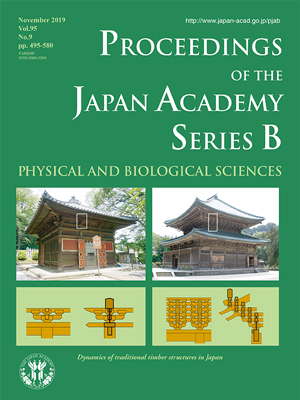About the Cover
Vol. 95 No. 9 (2019)
In Japan, academic interest and challenge in architecture were devoted to new building construction in the last century. New architectural theory and design flourished, supported by vigorous engineering progress. The advancement in earthquake engineering enabled the construction of super-high-rise buildings in such a seismically active region. However, the evaluation of historic architecture from the viewpoint of engineering had long been neglected and was supported by a few researchers.
The natural environment in Japan can be severe for timber structures. The heat and humidity accompanied by the rainy season affect timber components, and persistent earthquakes and typhoons can be hazardous to building structures. Despite this, many timber structures have existed for more than 1,000 years.
The illustrations in the cover show two halls of Buddhist temples and details of their bracket complexes. Kitain, illustration on the left, is a Tendai sect temple in Kawagoe, established in the 9th century by imperial command. Situated within the temple, Jigen-do is one of the halls wherein the late head monk Tenkai is worshipped. Kencho-ji, illustration on the right, is one of the first Zen sect temples in Kamakura established in the 13th century. The Butsu-den is one of the two main halls in Kencho-ji. The two buildings have different backgrounds but were both constructed in the mid-17th century using a three span by three span plan.
The bracket complex is one of the multiple elements constituting traditional timber architecture. As seen in the illustration, Kitain Jigen-do has a simple bracket complex, whereas that of Kencho-ji Butsu-den is elaborately layered. Bracket complexes are composed of combinations of cubic and beam-like elements with wide variety in the resulting detail and morphology. Experimental and analytical studies introduced in this journal reveal that the bracket complexes are not mere decorative elements; they have the potential to contribute as energy dissipation devices and decrease response in the course of seismic events.
Traditional timber structures in Japan have been repetitively damaged by earthquakes, but some structures are proven to have considerable earthquake resistance. Professor Fujita, author of the article “Dynamic performance of bracket complexes used in traditional timber structures in Japan” (pp. 568-580), is one of the few researchers who have devoted their academic career to revealing the fundamental characteristics of traditional timber structures from the perspective of engineering. This is an upcoming discipline in which Japan is expected to lead, especially among Asian countries, with rich and promising resources.
Isao Sakamoto
Professor Emeritus, The University of Tokyo
The photo to the upper left is taken by Kotaro Saito (former graduate student of The University of Tokyo) with the permission of Kitain. The photo to the upper right is taken by K. Fujita with the permission of Kencho-ji. The drawing to the lower left is by K. Fujita and is based on “Repair report of Sanmon, Syouroumon, Jigen-do, Kuri, Syoin, and Kyakuden of Kita-in temple, Important cultural property” (Courtesy of Kitain). The drawing to the lower right is by K. Fujita and is based on “Measurement Survey Report of National Treasures and Important Cultural Properties (Architecture) Vol. 3 (Tokyo and Kanagawa)” (Courtesy of Agency for Cultural Affairs).




